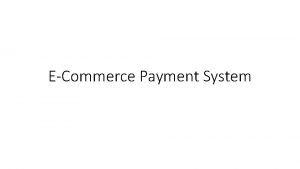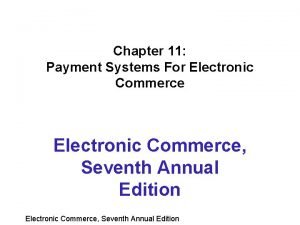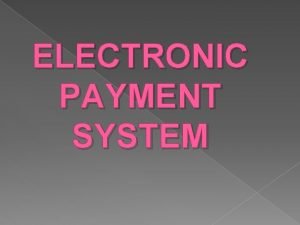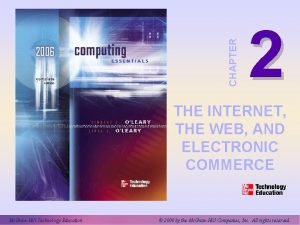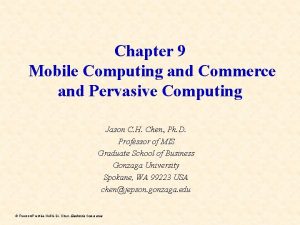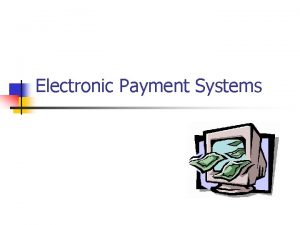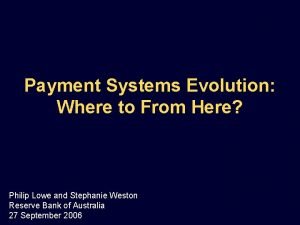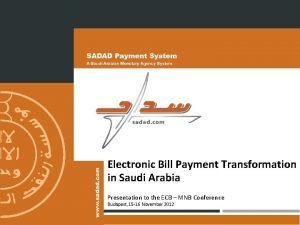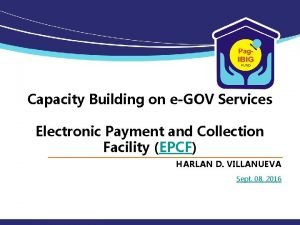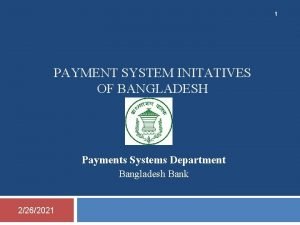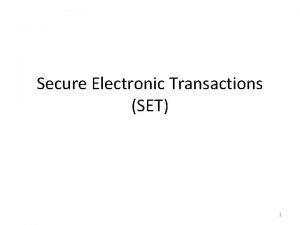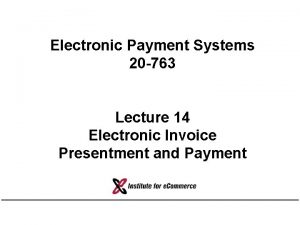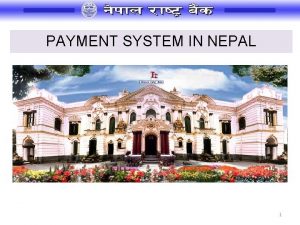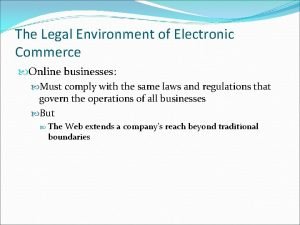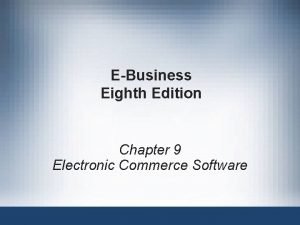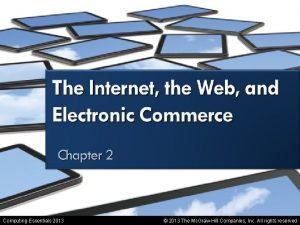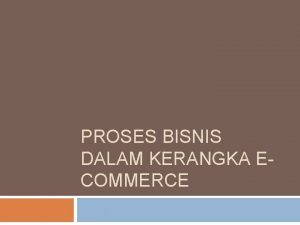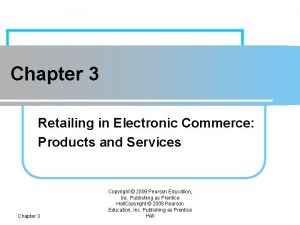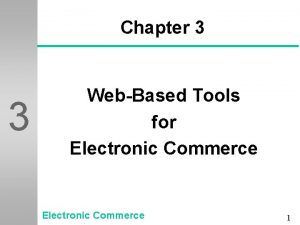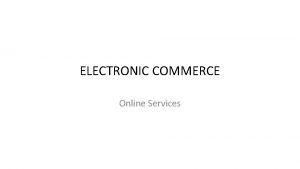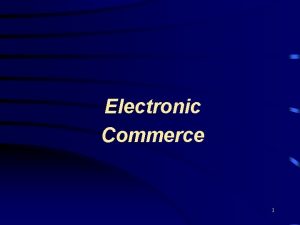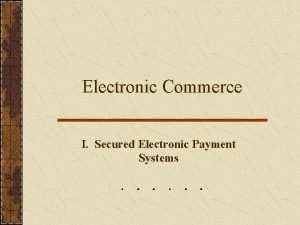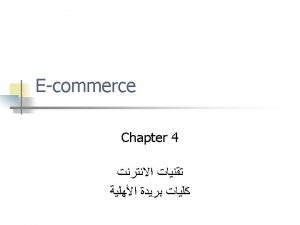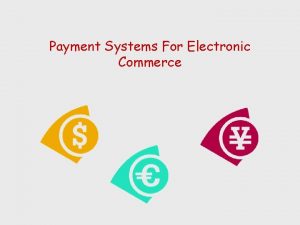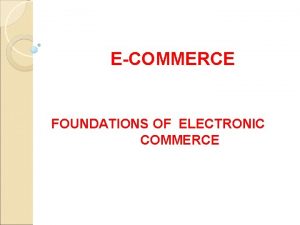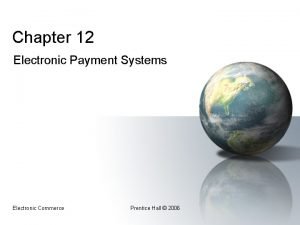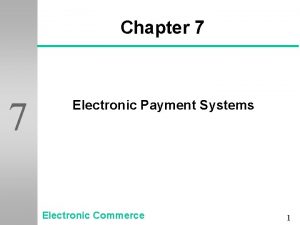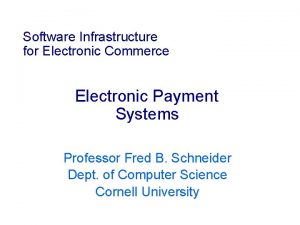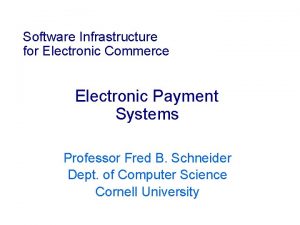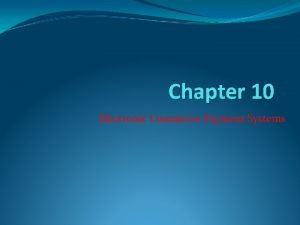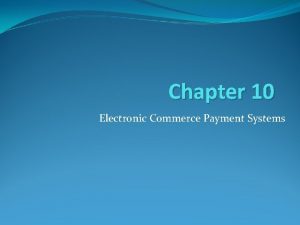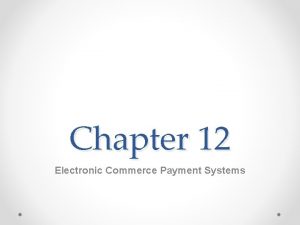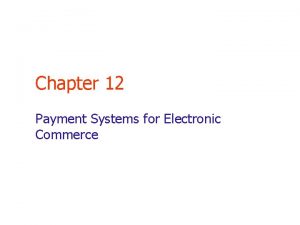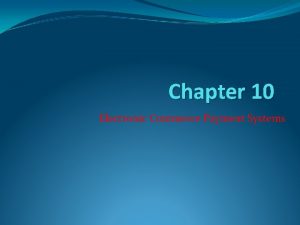Chapter 07 a Electronic Commerce Payment Systems Learning





















- Slides: 21

Chapter 07 a Electronic Commerce Payment Systems

Learning Objectives 1. Understand the shifts that are occurring with regard to online payments. 2. Discuss the players and processes involved in using credit cards online. 3. Discuss the different categories and potential uses of smart cards. 4. Discuss various online alternatives to credit card payments and identify under what circumstances they are best used. 5. Describe the processes and parties involved in e-checking. 6. Describe payment methods in B 2 B EC, including payments for global trade. Copyright © 2010 Pearson Education, Inc. Publishing as Prentice Hall 11 -1

The Payment Revolution • Today, we are in the midst of a worldwide payment revolution, with cards and electronic payments taking the place of cash and checks • A number of factors come into play in determining whether a particular method of epayment achieves critical mass Copyright © 2010 Pearson Education, Inc. Publishing as Prentice Hall 11 -2

The Payment Revolution – – – – – Independence Interoperability and Portability Security Anonymity Divisibility Ease of Use Transaction Fees International Support Regulations Copyright © 2010 Pearson Education, Inc. Publishing as Prentice Hall 11 -3

Using Payment Cards Online • payment card Electronic card that contains information that can be used for payment purposes • Three forms of payment cards: 1. Credit cards 2. Charge cards 3. Debit cards Copyright © 2010 Pearson Education, Inc. Publishing as Prentice Hall 11 -4

Using Payment Cards Online • PROCESSING CARDS ONLINE – authorization Determines whether a buyer’s card is active and whether the customer has sufficient funds – settlement Transferring money from the buyer’s to the merchant’s account Copyright © 2010 Pearson Education, Inc. Publishing as Prentice Hall 11 -5

Using Payment Cards Online – There are three basic configurations for processing online payments used by merchants: • • • Own the payment software Use a point of sale system (POS) operated by an acquirer Use a POS operated by a payment service provider – payment service provider (PSP) A third-party service connecting a merchant’s EC system to the appropriate acquiring bank or financial institution. PSPs must be registered with the various card associations they support Copyright © 2010 Pearson Education, Inc. Publishing as Prentice Hall 11 -6

Using Payment Cards Online • The key participants in processing card payments online include the following: – Acquiring bank – Credit card association – Customer – Issuing bank – Merchant – Payment processing service – Processor Copyright © 2010 Pearson Education, Inc. Publishing as Prentice Hall 11 -7

Using Payment Cards Online • FRAUDULENT CARD TRANSACTIONS – The key tools used in combating fraud: • Address Verification System (AVS) Detects fraud by comparing the address entered on a Web page with the address information on file with the cardholder’s issuing bank • card verification number (CVN) Detects fraud by comparing the verification number printed on the signature strip on the back of the card with the information on file with the cardholder’s issuing bank • Negative lists Copyright © 2010 Pearson Education, Inc. Publishing as Prentice Hall 11 -8

Smart Cards • smart card • An electronic card containing an embedded microchip that enables predefined operations or the addition, deletion, or manipulation of information on the card Copyright © 2010 Pearson Education, Inc. Publishing as Prentice Hall 11 -9

Smart Cards • TYPES OF SMART CARDS – contact card A smart card containing a small gold plate on the face that when inserted in a smart card reader makes contact and passes data to and from the embedded microchip – contactless (proximity) card A smart card with an embedded antenna, by means of which data and applications are passed to and from a card reader unit or other device without contact between the card and the card reader Copyright © 2010 Pearson Education, Inc. Publishing as Prentice Hall 11 -10

Smart Cards – smart card reader Activates and reads the contents of the chip on a smart card, usually passing the information on to a host system – smart card operating system Special system that handles file management, security, input/output (I/O), and command execution, and provides an application programming interface (API) for a smart card Copyright © 2010 Pearson Education, Inc. Publishing as Prentice Hall 11 -11

Smart Cards • APPLICATIONS OF SMART CARDS – Retail Purchases – Transit Fares Copyright © 2010 Pearson Education, Inc. Publishing as Prentice Hall 11 -12

Stored-Value Cards • stored-value card A card that has monetary value loaded onto it and that is usually rechargeable Copyright © 2010 Pearson Education, Inc. Publishing as Prentice Hall 11 -13

E-Micropayments • e-micropayments Small online payments, typically under $10 – Five basic micropayment models that do not depend solely or directly on credit or debit cards: 1. 2. 3. 4. 5. Aggregation Direct payment Stored value Subscriptions À la carte Copyright © 2010 Pearson Education, Inc. Publishing as Prentice Hall 11 -14

E-Checking • e-check(past year quest nov 2008) A legally valid electronic version or representation of a paper check – Automated Clearing House (ACH) Network A nationwide batch-oriented electronic funds transfer system that provides for the interbank clearing of electronic payments for participating financial institutions Copyright © 2010 Pearson Education, Inc. Publishing as Prentice Hall 11 -15

Copyright © 2010 Pearson Education, Inc. Publishing as Prentice Hall 11 -16

B 2 B Electronic Payments • CURRENT B 2 B PAYMENT PRACTICES – The goal of financial supply chain management is to optimize: • • Accounts payable (A/P) Accounts receivable (A/R) Cash management Working capital Transaction costs Financial risks Financial administration Copyright © 2010 Pearson Education, Inc. Publishing as Prentice Hall 11 -17

B 2 B Electronic Payments • enterprise invoice presentment and payment (EIPP) Presenting and paying B 2 B invoices online – EIPP Models • Seller Direct • Buyer Direct • Consolidator Copyright © 2010 Pearson Education, Inc. Publishing as Prentice Hall 11 -18

B 2 B Electronic Payments – EIPP Options • ACH Network • purchasing cards (p-cards) Special-purpose payment cards issued to a company’s employees to be used solely for purchasing nonstrategic materials and services up to a preset dollar limit • Fedwire or Wire Transfer • letter of credit (L/C) A written agreement by a bank to pay the seller, on account of the buyer, a sum of money upon presentation of certain documents Copyright © 2010 Pearson Education, Inc. Publishing as Prentice Hall 11 -19

Managerial Issues 1. What payment methods should your B 2 C site support? 2. What e-micropayment strategy should your emarketplace support? 3. What payment methods should B 2 B exchanges support? 4. What payment methods should a C 2 C marketplace support? 5. Should we outsource our payment gateway service? 6. How secure are e-payments? 7. What is the required security to use Internet banking? Copyright © 2010 Pearson Education, Inc. Publishing as Prentice Hall 11 -20
 Online stored value payment system
Online stored value payment system Payment systems for electronic commerce
Payment systems for electronic commerce Electronic payment system definition
Electronic payment system definition Chapter 2 the internet the web and electronic commerce
Chapter 2 the internet the web and electronic commerce Location-based commerce (l-commerce)
Location-based commerce (l-commerce) Objective of online payment system
Objective of online payment system Future of electronic payment system
Future of electronic payment system Evolution of electronic payment system
Evolution of electronic payment system Secure electronic transaction advantages disadvantages
Secure electronic transaction advantages disadvantages Electronic bill presentation and payment
Electronic bill presentation and payment Aub egov
Aub egov Bangladesh automated clearing house
Bangladesh automated clearing house Secure electronic payment
Secure electronic payment Future of electronic payment system
Future of electronic payment system Payment system in nepal
Payment system in nepal The legal environment of electronic commerce
The legal environment of electronic commerce Enterprise-class electronic commerce software:
Enterprise-class electronic commerce software: The internet the web and electronic commerce
The internet the web and electronic commerce Proses bisnis dalam kerangka electronic commerce
Proses bisnis dalam kerangka electronic commerce Electronic commerce software
Electronic commerce software Retailing in electronic commerce products and services
Retailing in electronic commerce products and services Web based tools for electronic commerce
Web based tools for electronic commerce
